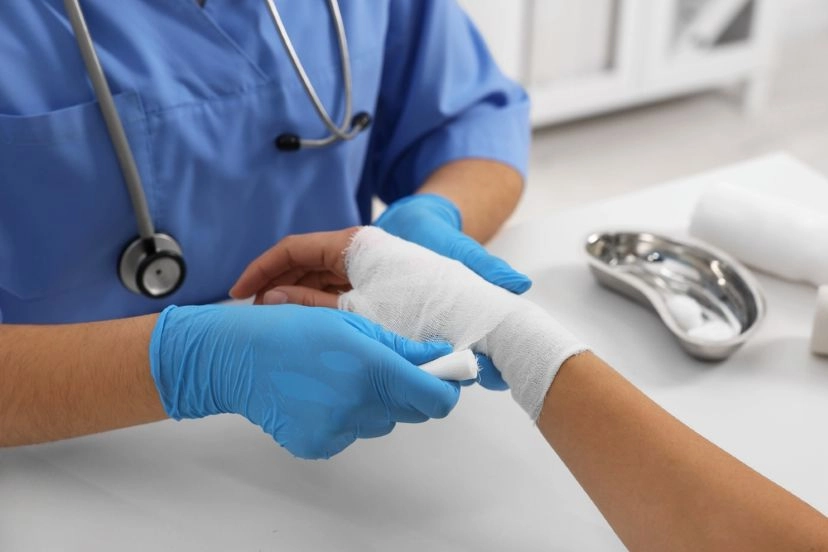Knee Osteoarthritis is common but often overlooked condition

Knee osteoarthritis is one of the most common joint disorders, particularly among the elderly. However, did you know that it is increasingly being diagnosed in younger individuals? This is largely due to daily lifestyle habits that put stress on the knee joints—such as frequent kneeling or squatting, climbing stairs often, or being overweight. Although knee osteoarthritis tends to progress gradually, if left untreated, it can lead to joint deformity, difficulty walking, and a significant decline in quality of life.
Knee Osteoarthritis Symptoms You Shouldn’t Ignore
Symptoms of knee osteoarthritis often begin gradually and worsen over time if not properly managed. Key warning signs include:
1.Knee pain, especially when moving, walking, or getting up and down
2.Cracking or grinding sounds in the knee joint
3.A sensation of stiffness or resistance when moving the knee
4.Swelling, warmth, or redness around the knee
5.Limited range of motion—difficulty fully bending or straightening the knee
6.In some cases, visible deformity such as bowing of the legs
If you experience persistent symptoms lasting more than two weeks, it is recommended to consult a doctor for proper diagnosis and a tailored treatment plan.
Risk Factors for Knee Osteoarthritis
Several factors can accelerate the development of knee osteoarthritis, particularly those related to lifestyle habits and age-related physical changes. These include
1.Advancing Age
As we age, the cartilage that cushions the knee joint naturally begins to deteriorate. This leads to increased friction within the joint and a reduction in joint fluid, making the knees more vulnerable to osteoarthritis. Studies show that individuals aged 45 and older face a steadily rising risk, with a significant increase after age 60.
2.Excess Body Weight
Being overweight is a major risk factor for knee osteoarthritis. Every step places extra pressure on the knee joints, and medically, it’s found that each additional kilogram of body weight adds 3 to 4 times that load to the knees. Even a slight excess in weight can significantly accelerate knee cartilage degeneration.
3.Overuse of the Knee Joints
Repeated, high-impact use of the knees can wear down cartilage prematurely. Risky activities include:
- Long-distance running
- High-impact sports involving jumping or quick directional changes (e.g., basketball, football)
- Frequent heavy lifting at work
These actions place excessive stress on the knee joints, increasing the risk of early-onset osteoarthritis.
4.Previous Knee Injuries
Past knee injuries—such as anterior cruciate ligament (ACL) tears, meniscus tears, or knee fractures—can have lasting effects on joint stability and function. Even with treatment, these injuries can lead to imbalance and abnormal joint wear, contributing to earlier onset of knee osteoarthritis.
Treatment Options for Knee Osteoarthritis
Treatment for knee osteoarthritis depends on the stage of the disease, the severity of symptoms, and the overall health condition of the patient. Generally, treatment can be divided into two main categories: non-surgical and surgical interventions.
1. Non-Surgical Treatments
In the early stages or when symptoms are not severe, the goal is to slow down joint degeneration, relieve symptoms, and strengthen the knee to avoid or delay surgery. These include:
- Lifestyle modifications:
Weight loss is a key strategy, as excess weight increases pressure on the knees and accelerates cartilage wear. Avoiding behaviors that strain the knees—such as prolonged kneeling or squatting, heavy lifting, or frequent stair use—can help preserve joint health.
- Physical therapy:
Focuses on strengthening muscles around the knee, especially the quadriceps and hamstrings, to reduce joint stress. Therapy may also include stretching and balance training to improve joint function.
- Medications:
Pain relief may include acetaminophen or non-steroidal anti-inflammatory drugs (NSAIDs) like ibuprofen. Some medications may help slow cartilage degeneration in selected cases.
- Hyaluronic acid injections:
Intra-articular injections of hyaluronic acid can improve joint lubrication, reduce friction, and ease pain, particularly in early to moderate stages.
- Steroid injections:
Corticosteroids can help control acute inflammation and pain in severely inflamed joints, but repeated use is discouraged due to potential cartilage damage.
- PRP Cold Brew injections (Platelet-Rich Plasma):
Ideal for early to moderate knee osteoarthritis, this treatment involves drawing 11–22 ml of the patient’s blood, processing it to concentrate platelets rich in growth factors, and injecting it into the affected knee. It aims to slow degeneration and promote tissue repair.
2. Surgical Treatments
Surgery may be necessary if symptoms are severe—such as extreme pain, joint deformity, or poor response to conservative treatment. Options include:
- Arthroscopic surgery:
Minimally invasive procedure to remove loose cartilage fragments or perform minor repairs. Best for specific localized issues but not a long-term solution for widespread degeneration.
- Total Knee Replacement (TKR):
Recommended for severe osteoarthritis affecting the entire knee joint, especially with deformity or disabling pain. The worn surfaces are replaced with prosthetic materials to restore function and reduce pain.
- Partial Knee Replacement (Unicompartmental Knee Arthroplasty):
Suitable for patients with damage limited to one part of the knee. Only the affected compartment is replaced, preserving more natural joint function.
- High Tibial Osteotomy (HTO):
Aimed at correcting leg alignment in patients with bow-legged deformity (O-leg) and medial knee joint degeneration. The upper shin bone is surgically realigned to redistribute pressure more evenly across the joint.
Prevent Knee Osteoarthritis—Start Today
While knee osteoarthritis is often age-related, there are many ways to reduce the risk by taking care of your joint health:
1.Maintain a healthy body weight
2.Engage in low-impact exercises such as brisk walking, swimming, or cycling
3.Avoid prolonged kneeling or squatting
4.Consume calcium and vitamin D supplements as needed
5.Get regular knee health checkups—especially if you are in a high-risk group
Knee osteoarthritis can be managed and treated effectively—especially when diagnosed early. A personalized treatment approach can help relieve pain, restore joint function, and extend the lifespan of your knees.
If you're experiencing early symptoms such as knee pain, stiffness, tightness, or cracking sounds in the joint, don’t wait until the condition worsens. Consult a specialist at Phyathai 2 Hospital, where our team of orthopedic experts is equipped with advanced diagnostic and treatment technologies for knee osteoarthritis. We offer comprehensive care, personalized solutions, and innovative surgical options for the best possible outcomes.
Don't wait until the damage is severe—visit Phyathai 2 Hospital today and take the first step toward pain-free movement.


